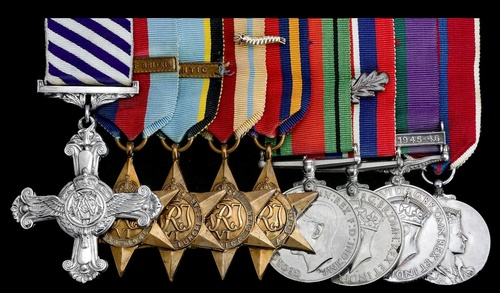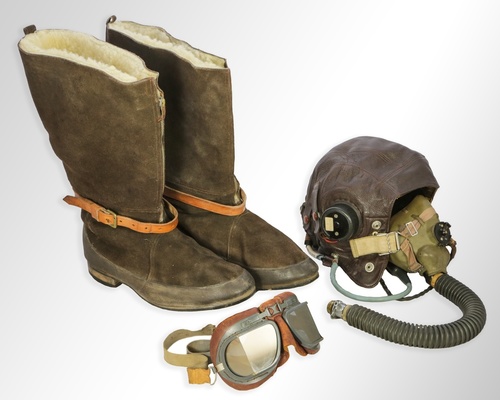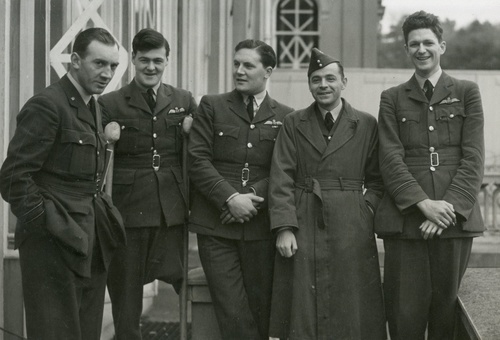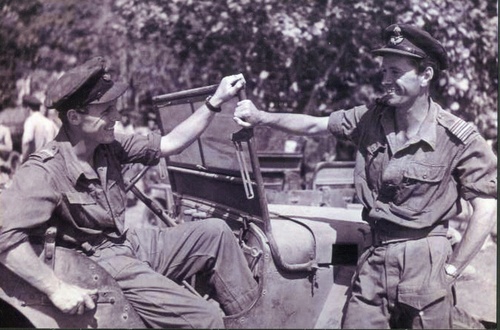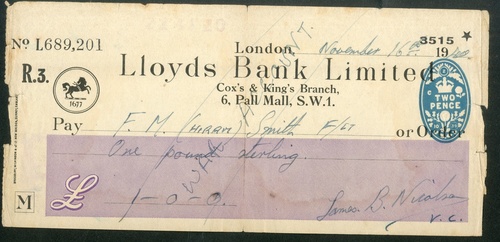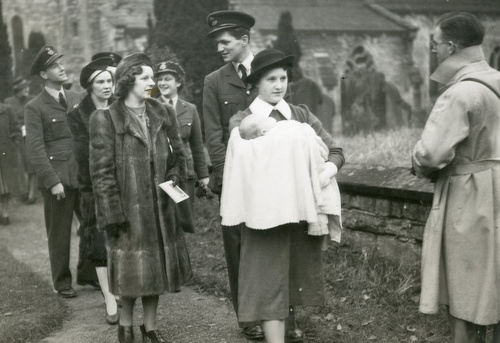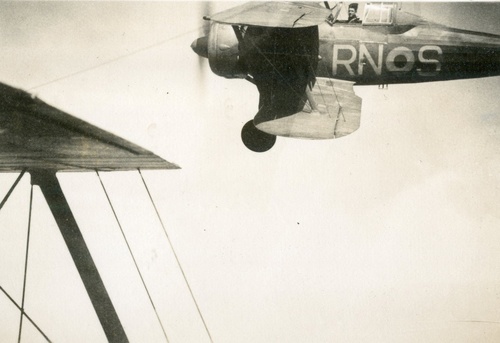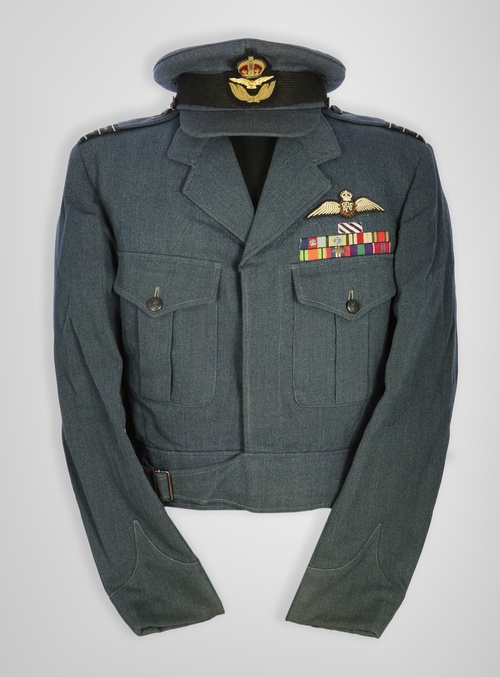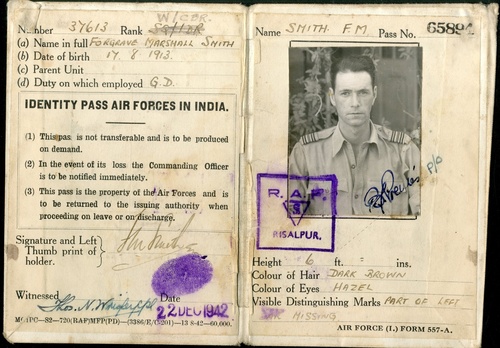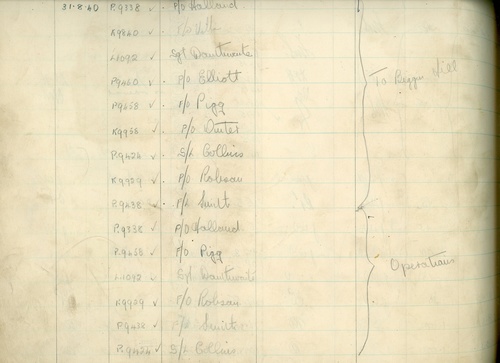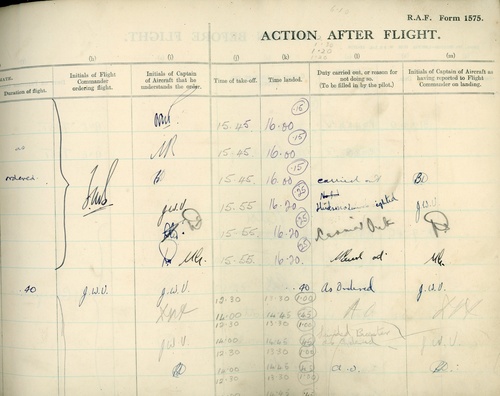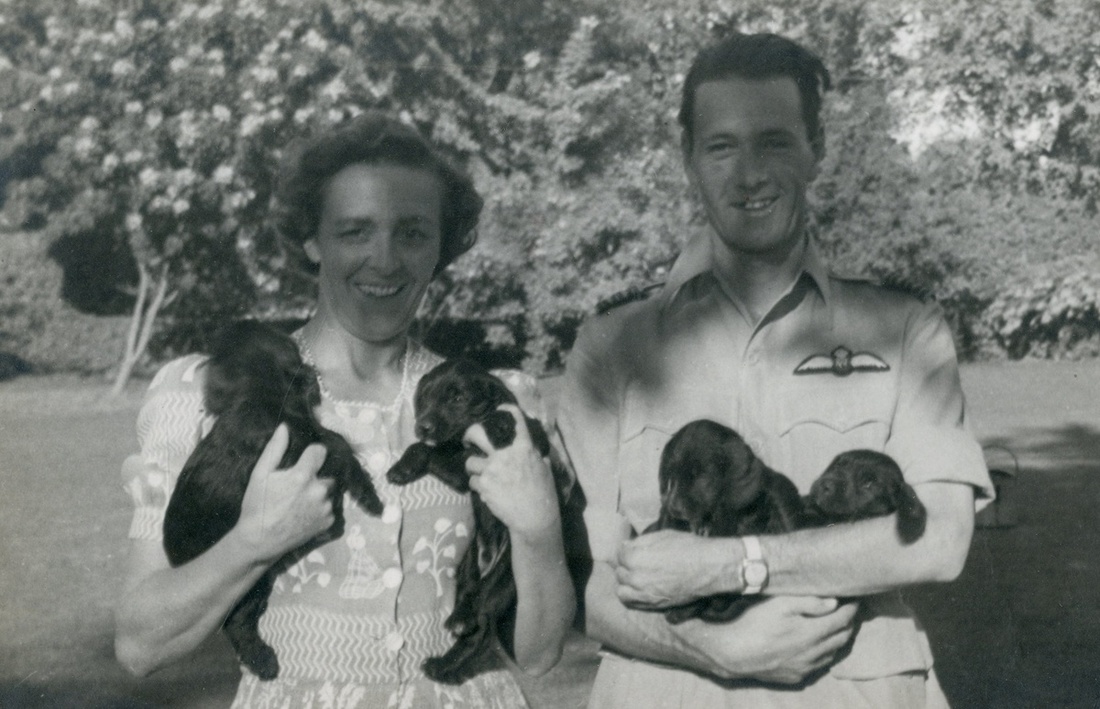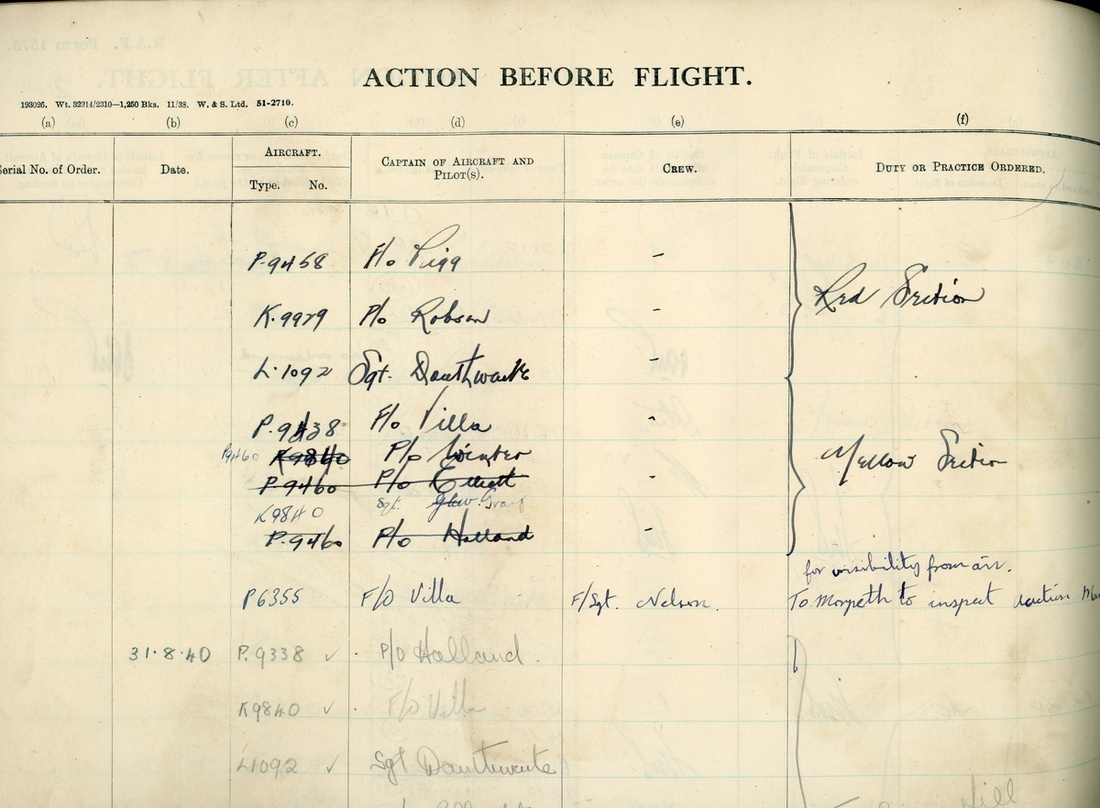Auction: 18001 - Orders, Decorations and Medals
Lot: 33
'On 31 August 1940, I took off from Biggin Hill leading a section of four Spitfires of No. 72 Squadron and intercepted 100 plus enemy aircraft crossing the Kent coast near Rye. We were attacked by Me. 109s at 20,000 feet and turned head on to the attack. I saw puffs of smoke from the cannon of the leading 109 and thought 'missed me' - but not for long: a 20mm. cannon shell exploded on hitting the left earphone of my flying helmet, penetrating my head and neck, with splinters hitting my left arm.
The aircraft was seriously damaged by other hits and became out of control, diving vertically towards the ground. I tried to bale out but owing to the very high speed it was not possible to get more than half way out of the cockpit. The slipstream forced me back against the rear of the fuselage and repeated efforts only resulted in it becoming impossible to move in or out of the cockpit or to find anything against which I could push with my feet. Every effort having been made to no avail - and having gone through the full range of emotions embracing urgency, frustration, consternation, fear, panic and supplication - it was clear to me that owing to the speed at which I was approaching the ground it could only be a matter of moments until I hit it. I then became completely relaxed and resigned myself to imminent extinction.
In the event, I suddenly found myself free of the diving Spitfire and, quickly pulling my rip cord, descended the last 1000 feet or so by parachute at a relatively leisurely pace. The wind dragged me across a field before I was able to deflate the parachute. I found the operation rather difficult, probably, in part, through exhaustion after the effort of getting out of the aeroplane and partly due to the effect of the cannon shell which on exploding against my left ear had penetrated my head and neck and, in the process, blown the top off my Mae West!
Whilst releasing my parachute I looked up into the barrel of a .303 rifle aimed menacingly at me by a soldier of the Home Guard. I said to him "British", which explanation he seemed to find less than adequate. I then tried "English" whereupon he slowly lowered his rifle. By that time it had become clear to him that in my condition, whether friend or foe, I was in no shape to threaten him.
In due course I was transported to No. 7 Casualty Clearing Station, a hospital located in a well-known girls' school, Benenden, attended many years later by Princess Anne, and of which establishment I feel I may well claim to be an 'Old Boy' … '
High drama over Kent at the height of the Battle of Britain, as related by Wing Commander F. M. 'Hiram' Smith, D.F.C., a Spitfire pilot in No. 72 Squadron.
The quite outstanding Second World War fighter ace's D.F.C. group of nine awarded to Wing Commander F. M. 'Hiram' Smith, Royal Air Force, a most gallant Canadian pilot whose name remains indelibly linked to the Battle of Britain
Having destroyed a pair of He. IIIs piloting a Spitfire of No. 72 Squadron in mid-August 1940 - and probably claimed another - he was shot down in a combat over Kent at the end of the month, when he received multiple wounds from a cannon shell: among fellow patients in his hospital ward was his friend - and ex-72 pilot - Flight Lieutenant E. J. B. Nicolson, V.C., who promptly wrote him out a cheque for £1 in payment for a bet they had taken earlier in the war
On recovering from his wounds, 'Hiram' was given command of No. 603 (City of Edinburgh) Squadron and quickly returned to form, shooting up a brace of 109s during cross-Channel sweeps in the summer of 1941. By the war's end, he had completed four tours of duty, 280 operational sorties and had risen to the command of 902 Wing on the Burma front
Many years later 'Hiram' was delighted to discover that one of his old war horses - Spitfire Mk. 1 K9942 - had also survived the war. Flown by both him and Nicolson in 72 Squadron in the early part of 1940, K9942 today resides in the collection of the Royal Air Force Museum at Hendon
The accompanying documentation and photographs - particularly in respect of No. 72 Squadron and Nicolson, V.C. - constitute an important discovery for archivists and historians alike
Distinguished Flying Cross, G.VI.R., the reverse officially dated '1945', with its Royal Mint case of issue; 1939-45 Star, clasp, Battle of Britain; Air Crew Europe Star, clasp, Atlantic; Africa Star; Burma Star; Defence and War Medal with M.I.D. oak leaf; General Service 1918-62, 1 clasp, S.E. Asia 1945-46 (Wg. Cdr. F. M. Smith. R.A.F.); Coronation 1953, mounted as worn, together with Caterpillar Club membership badge, by Irving Co., in gold, with 'ruby' eyes, the reverse officially inscribed, 'F./Lt. F. M. Smith', good very fine (10)
D.F.C. London Gazette 30 October 1945. The original recommendation states:
'Wing Commander Smith has completed four tours of operational duty. His first and second tours were completed during the Battle of Britain and consisted of interception sorties, convoy patrols and day and night cover over Dunkirk, France and Britain. His third operational tour was completed in the Middle East and his fourth in Burma. This officer has destroyed at least five enemy aircraft and damaged others. He has recently taken part in operations against Japanese lines of communications over mountainous and dangerous country. As Wing Commander (Flying) of his present unit he has displayed exceptional keenness at all times.
Wing Commander Smith is in his fourth operational tour and has carried out 280 operational sorties involving 346 hours flying.
This officer's first and second tours were carried out during the Battle of Britain and consisted of interception, convoy patrols, day and night cover over Dunkirk and sweeps over France and Belgium during which time he carried out 236 operational sorties involving 300 hours flying. During the Battle of Britain he was wounded in the head by a cannon shell. His third tour was carried out in the Middle East and consisted of bomber escorts and fighter sweeps over Alamein involving 16 sorties totalling 17 hours flying. This tour was terminated on his posting to India.
During the above operational tours he has destroyed three Ju. 88s, one Do. 17, one Me. 109 and damaged one Me. 110 and three Me. 109s.
Wing Commander Smith is now in his fourth operational tour and has carried out 28 operational sorties involving 30 hours flying in the Burma theatre of operations. He has taken part in escort to bombers, bombing and ground strafing Japanese positions and sampans over the worst type of country to be found in any theatre of operations. His record shows that he has been almost continuously on operational flying throughout the present hostilities.
As Wing Commander Sweep Leader during his present tour he has displayed exceptional keenness and has at all times set a very high example to the pilots of his squadrons in the Wing.'
Forgrave Marshall 'Hiram' Smith was born in Edmonton, Alberta on 17 March 1913 and was educated at Oliver & Westmount High School and Victoria High School. Having then served in the Canadian Militia and obtained a private pilot's licence, he gained an appointment as a Pilot Officer on probation in the Royal Air Force in March 1936.
Qualifying for his 'Wings' at R.A.F. Grantham, he was posted to No. 1 Squadron at Tangmere, from which unit emerged the nucleus of No. 72 Squadron in early 1937 - at that stage a Gloster Gladiator unit, No. 72 was re-equipped with Spitfires in April 1939. Among Smith's fellow officers was Pilot Officer E. J. B. Nicolson, who became a close friend and Fighter Command's only V.C. for his gallantry as a Hurricane pilot in No. 249 Squadron in the Battle of Britain.
Based at Church Fenton in the opening months of the war, No. 72 flew convoy and defensive patrols, often in atrocious weather conditions. Smith was compelled to make 'blind landings' on more than one occasion. It was on one such patrol on 29 June 1940 that he gained his first victory, a share in a Do. 17 which crashed into the sea off May Island, but not before meeting determined return fire:
'Back on the airfield at Acklington it became apparent that it was nearly a one-way trip for me as well. An armour piercing bullet had just missed the glycol tank in my aircraft and had skipped along a line of rocker arms in the Merlin engine. The hard nose of the bullet was recovered from its stopping point in the engine and handed to me by the Flight Sergeant' (his hitherto unpublished sketches of wartime service, refer).
The Battle of Britain - Caterpillar Club
A Flight Commander by the advent of the Battle of Britain, Smith quickly increased his score on 15 August 1940, when he shot down two He. IIIs and probably destroyed another:
'Turning in behind a formation of bombers, I opened fire at one hitting its starboard engine, which started to smoke and large pieces flew off the main plane. I swung quickly behind another bomber firing a short burst into its port engine. I then transferred the attack to the third Heinkel, closing to point-blank range and I could see the incendiary bullets flash as they ricocheted on contact. I was close astern when the aircraft blew up with a tremendous explosion and disintegrated in a ball of fire, which I narrowly avoided flying into …' (ibid).
Towards the end of the August, No. 72 was ordered to Biggin Hill, from whence Smith undertook his final sortie of the Battle. Scrambled just an hour or two after their arrival, the Squadron was vectored onto a mass of enemy bombers, with 109s as escort, over Kent. Diving to the attack, Smith ran into a 109 making a head-on pass with guns blazing: a cannon shell exploded near his head and left him with multiple wounds.
His vivid account of his subsequent battle to escape his shot-up Spitfire invokes all manner of imagery - quite terrifying imagery - so relevant to the airmen who fought in the Battle of Britain. His somewhat unfortunate reception on landing was not dissimilar to that experienced by his good friend E. J. B. Nicolson, on the occasion that he won the V.C., although in Smith's case his accent may have confused the Home Guard soldier, 'for Hiram never lost his Canadian accent.'
Be that as it may, he was carted off to Benenden School, now home to No. 7 Casualty Clearing Station.
Nicolson, V.C.
Subsequently admitted to the R.A.F. hospital at Halton, Smith was re-united with his old friend, 'Nick' Nicolson, who had been shot down in flames in his Hurricane of No. 249 Squadron just three weeks earlier.
The pair of them would later be transferred to the Palace Hotel hospital at Torquay. It was here that the two pilots had an opportunity to review a long-standing bet they had taken earlier in the war - a £1 bet payable to the first man to be credited with a confirmed enemy aircraft. On comparing notes it transpired that Smith was the winner and Nicolson duly wrote him out a cheque: that cheque forms part of the accompanying archive.
It was also at Torquay that Nicolson was informed of his award of the V.C. Smith takes up the story:
'We met at the R.A.F. Hospital, Halton, about the end of December 1940. I had sustained 109 cannon shell injuries to my head and neck, and Nick had severe burns to his face and hands. At that time treatment for burns involved liberal coatings of gentian violet, which, added to their injuries, resulted in burns patients not being a pleasant sight … Sometime later I met Nick again at Torquay. Once again we had been to town at lunch time and, upon returning to the Palace Hotel and entering the front door, Nick was called over to the desk in the hall. I sat down on a settee at the opposite side of the room. A few moments later, a completely shattered Nicolson collapsed beside me and thrust a piece of paper into my hand. It was a telegram and the message started off 'His Majesty King George VI …', and I thought it must be a joke, but reading on it promulgated 'the award of the Victoria Cross to Flight Lieutenant J. B. Nicolson.' As I finished reading the message, Nick turned to me and said "Now I have to go and earn it." '
Many years later, Smith was interviewed by the R.A.F. historian, Chaz Bowyer; he also sent Bowyer an extensive typed account of wartime appointments and experiences shared with Nicolson. It constitutes an important insight into Nicolson's character, much of which remains unpublished. In respect of the catalyst behind the award of his V.C., he quotes the following story:
'Subsequently, he told me that he met several distinguished looking civilian gentlemen coming down the stairs as he went up. They were no doubt affected by his appearance and enquired what had happened to him. In his usual loquacious manner he gave them a graphic account of his encounter with the Me 110, his blazing Hurricane, his delayed bale out and destruction of the 110. What Nick didn't know until sometime later, was that the leader of this civilian group was Secretary of State for Air, Sir Archibald Sinclair'.
The pair of them remained firm friends up until Nicolson's death in Burma in May 1945. Back in 1940, Smith had happily accepted the Nicolson's invitation to become godfather to his son, James.
The following letter from Nicolson to Smith, dated 11 March 1941 - included in the accompanying archive - is a typical example of their wartime exchanges:
'We'd a bit of fun a wee while back, the 'suits' were all night flying, when a sportsman came over in a 110 (we identified him by his reserve fuel tank, carried in place of a rear gunner, & jettisoned near Selby).
He first shot up a Defiant & set one of its parachute flares alight. Robbie Burns was flying this however, and managed to land on the flare path, his flare going out as he touched down - all the same, he looked pretty exciting mowing round.
The bog friend then picked up another Defiant and beat him up to no mean tune, his flaps & wheels wouldn't work and he parked it in a heap. The 110 then chased a Blenheim half way round Yorkshire, & the R/T was like this:
Pupil: "Hullo control, I'm being shot at."
Control: "Hullo 61, your message understood, stand by for Controller."
Controller: "Hullo 61, don't be idiotic, there isn't a Hun within 60 miles."
Pupil: "Hullo Controller, he's just shot my port motor out."
Controller: "I should think it's probably backfired."
Pupil then sees a large field and parks the Blenheim nimbly on its belly (in the dead of night).
Pupil: "Hullo Controller, have pancaked in field, switching off, Off!"
Who the controller was I don't know, but they do say he hasn't been much good since, and he now sees 109's & 110's heating up his soup at lunch and leaves the room with an unearthly shriek.
Ma sends her love & says I'm to tell you your godson is thriving. I haven't got him on beer yet. Love to Des and all the other bad types, not forgetting Sam Staples. Oh! For the bad old days.
Yours aye, Nick.'
Return to the fray
Smith returned to flying duties with No. 72 after three months in hospital. Posted to No. 603 (City of Edinburgh) Squadron in April 1941, he commenced a flurry of cross-Channel sweeps and was credited with damaging 109s west of Ostend and west of Calais in mid-June:
'We spent the summer carrying out intensive fighter operations over France during which time we had successes and also some very heavy casualties, mainly due to the fact that we nearly always flew as 'Top Cover' for the Hornchurch Wing and consequently took the brunt of 109 attacks' (ibid).
As related in the pages of The Queen's Squadron, by Anthony Ross, D.F.C., Smith nearly joined the list of casualties on 23 July 1941:
'On the same day 603 provided an eight aircraft escort to a Lysander. P./O. Hugh Blackall's engine cut out. Hiram Smith told him to bale out but he preferred to land in the sea. The aircraft submerged quickly and it was some time before he came to the surface. Hiram flew low over him and could see that he was in a bad state. His dinghy had not inflated and there was no contact with, or sight of, an A.S.R. launch. Hiram Smith thought at first of baling out to assist him but decided he could not be sure of landing near enough. He recklessly decided to try and throw his own dinghy to him. He managed to separate it from his parachute and slightly inflate it. Flying low over Blackall he tried to throw it out. After two or three attempts he had to give up as he found it impossible to drop it with sufficient accuracy.
Hiram himself was now in a difficult position circling around in mid Channel with a cockpit full of dinghy and an unusable parachute. An A.S.R. launch eventually arrived and pulled Blackall out. He had been 52 minutes in the water and was picked up still alive. He died however at Margate. Hiram who had been circling for nearly an hour headed for Rochford grateful that no 109s had seen him since he was in no condition to engage in combat.'
He left the Squadron in July, on being posted to No. 52 O.T.U. at Debden as Chief Flying Instructor.
Middle East and Burma
Having then commanded No. 145 Squadron in North Africa in early 1942, where he flew 16 sorties over the Alamein and Gazala sectors, Smith was ordered to India as Chief Flying Instructor at Risalpur.
He next attended the R.A.F. Staff College at Haifa and was appointed Wing Commander (Operations) at Air H.Q., New Delhi, prior to returning to the U.K. to attend the Fighter Leaders' School.
Back in India, he was appointed C.O. and Wing Commander Sweep Leader of No. 902 Wing, and it was in this capacity that he flew a further 28 operational sorties, 'bombing and ground strafing Japanese positions and sampans over the worst type of country to be found in any theatre of operations.'
He also served as Joint Assault Commander for the invasion of Ramree island on the Arakan coast and, in May 1945, participated in the invasion of Rangoon. He was awarded the D.F.C. and was mentioned in despatches (London Gazette 8 June 1944, refers).
In September 1945, Smith led 11 and 17 Squadrons off the deck of H.M.S. Trumpeter to Malaya as part of Operation "Zipper", following which he served as Wing Commander Air Staff at A.H.Q., Dutch East Indies, Batavia, Java (Medal & clasp).
Having retired from the Royal Air Force as a Wing Commander in October 1957, Smith joined British Petroleum (B.P.) and worked in the company's Head Office in London for sixteen years, latterly as a Departmental Personnel Manager.
Much in demand as a Canadian Battle of Britain veteran, he was a regular contributor to documentaries, articles and published histories. He was also among those surviving pilots featured in the battle's 50th Anniversary art folio, So Few:
'Hiram has never lost his Canadian accent and can still be comfortable in his uniform. Befitting a big man with a commanding presence, he lives in a roomy house in the environs of the little stone village of Dunning, some ten miles south-west of Perth in Scotland. The air sweeps down from the Highlands, and while his wife portrays the Scottish colours on canvas, he catches salmon from the local river Earn.
Few men have had such an adventurous and action-packed war, covering the major theatres of conflict across the globe. Canada made such a vital contribution to victory in the air, that it is fitting that a man like Hiram should personify that spirit in this fine art folio.'
Sold with an extensive - and important - archive of original documentation and photographs, including:
(i)
The recipient's original R.A.F. Pilot's Flying Log Books (3), bound as one in a soft brown leather cover; the first covering the period 11 January 1936 to 6 December 1938, with total flying of 533.20 hours, the majority as pilot of Gladiator, Fury and Magister aircraft and closes with entries for No. 72 Squadron and numerous references to Nicolson, V.C.; the second covering the period 1 December 1938 to 15 September 1945, with total flying of 1544.20 hours and Battle of Britain, North Africa and Burma entries; and the third the period
3 October 1945 to 15 July 1957, with total flying now 2169.25 hours, and including a comprehensive summary of sorties flown.
(ii)
His mention in despatches certificate in the name of 'Wing Commander F. M. Smith, Reserve of Air Force Officers', and dated 8 June 1944, in its original O.H.M.S. envelope, addressed to Smith at Bentley Priory, Stanmore; together with his Coronation Medal 1953 award certificate in the name of 'Wing Commander Forgrave Marshal Smith, D.F.C. (37313)'
(iii)
His commission warrant for the rank of Acting Pilot Officer, dated 17 March 1936.
(iv)
A comprehensive and historically important record of 'A' Flight, 72 Squadron during the Battle of Britain: R.A.F. A Form 1575 book, covering the period 15 June 1940 to 10 November 1940, with day by day, sortie by sortie account of aircraft and pilots, thus names, aircraft flown, section details (Red, Yellow, Blue), the duty ordered, and the actions and outcomes of said flights. The timeframe of each action is recorded, together with sign-out initials or signatures of the pilots; for example, on 29 June 1940, flying L1092, P./O. Winter of Yellow Section departed at 08.05 and landed at 09.45 and 'Intercepted Do. 17, shot down in flames': on the same sortie, the other two members of Yellow Section also claimed Do. 17s, including 'Flight Lieutenant Smith', 196 pp.
(v)
An interesting archive relating to E. J. B. Nicholson, V.C., including his signed £1 Lloyds Bank cheque made out to 'F. M. (Hiram) Smith', as given to the latter as they convalesced from wounds at Torquay on 16 November 1940, together with a handwritten account of the story behind the cheque in respect of an earlier bet taken between the two pilots; a letter from Nicolson to Smith, dated 11 March 1941, giving details of a recent enemy attack and informing Smith as to the health of his godson, as quoted above; a letter from R. C. Bowyer requesting information relating to Nicolson for his history of air VCs, dated 19 February 1970; together with highly detailed handwritten notes taken by him when interviewing Smith, approximately 6000 words, and a typed copy of the recipient's original statement to the author; a letter of thanks from Peter Mason regarding the loan of photographs and 'tremendous help' given to the production of the book Nicolson VC which was launched at the Yorkshire Air Museum, 16 August 1991; together with a selection of related photographs, including a half-length portrait photograph of Nicolson, annotated to reverse, 'Taken at R.A.F. Hospital, the Palace Hotel, Torquay, just before the award of the V.C. (Nov.) 1940'; Nicholson having just received his Victoria Cross from the King, surrounded by admirers; Nicholson playing darts, wearing his V.C. riband on his tunic; Nicholson, Smith and 'Chuck' Olsson, performing as part of an R.A.F band, annotated to reverse, 'Concert, Palace Hotel, Torquay, 1940'; formal group wedding photograph of Nicholson with his bride, bridesmaids and R.A.F. officers; a group photograph with accompanying paper slip, annotated by Smith, 'From Left to Right, Self, Mrs. Muriel Nicolson (sic) in fur coat, one of Nick's sisters in W.A.A.F. uniform, and Nick with Nanny and baby James at his Christening in 1940'; and a portrait photographs of 'Young Nicholson - Hiram's Godson'.
(vi)
Remittance document with respect to a £300 Short Service Gratuity, by Glyn, Mills & Co., 20 February 1940.
(vii)
Three portrait photographs of the recipient, in full dress officer's uniform with R.A.F. wings and ribands, taken at James Street, Harrogate; a further image of Smith and his father, and a group shot taken for Flight Magazine, annotated to reverse, '7th from right - front row of officers and men - note Senior Officer with his dog.'
(viii)
Photograph album, part complete, showing early training aircraft such as the Miles Hawk, group photographs or airmen and ground crew, and numerous images of pranged aircraft' approximately 27 photographs, and inserted newspaper cuttings and Christmas cards.
(ix)
A large formal black-tie dinner photograph by F. A. Swain Ltd, Clifford St., W.1., showing the pilots of No. 1 Squadron and No. 72 Squadron, R.A.F., with seating plan sketch, 'Hiram' identified, circa 1939; a second large image of a 72 Squadron Dinner at the R.A.F. Club, Smith identified again, with corresponding letter from Flying Officer D. Donaldson Davidson, asking Smith if he can assist with naming the attendees.
(x)
Snapshot photographs showing images from the Desert Campaign, including personal snapshots and images displaying the logistical challenges of heat and sparse landscapes (13); further photographs of the arming of Hurricanes in Burma and group shots of Indian pilots and ground staff (10).
(xi)
An amusing letter from Sergeant Carl Olmsted to the Chief Ground Instructor, 52 O.T.U., dated 13 October 1941; together with a letter from P./O. K. K. Gauguly, from the Officer's Mess, Bhopal, 10 March 1943; and further correspondence with friends and R.A.F. personnel in India.
(xii)
A diary of life in Burma, compiled in pencil, within a Century Exercise book, 75pp., labelled F. M. Smith to front cover; it includes a series of speeches compiled by Smith, addressing his feelings regarding Operational Training Units, Conversion Flights and early difficulties, and the expansion of the Indian Air Force and it goes on to describe his exploration adventures on foot around Chitral, before returning to military topics, including the logistics of waves of bombers and diversionary bombing.
(xiii)
Wartime Escape Maps in silk for Cyrenaica, North-West Europe and Burma; paper escape map showing Central Europe and the Swiss border (4); Ordnance Survey paper maps for Frome, Salisbury & Winchester, Isle of Wight; 1943-45 Air Sheet colour maps for London, Southern England, East Anglia (2), South-West England, South Wales, Midlands, North-East England (2), Northern Isles, Northern Ireland, North-East Scotland, Scottish Borders; colour map of Ireland and Paris.
(xiv)
Officer's Medical Record Card to '37613 Forgrave Marshall Smith', including R.A.F. certificates for inoculation against typhoid, smallpox, yellow fever & cholera; Medical Renewal Examination document for a Pilot's Licence for Private Flying Machines, dated 22 January 1944.
(xv)
Post-war photographs of Lubeck from the air taken by Smith, in envelope annotated '1947', displaying sunken ships in the harbour and bombed buildings (21); together with a travel permit from H.Q., U.S. Forces in Austria; Occupational Force Travel Permit, Vienna to London, 1951; a telegram to Smith at R.A.F. Lubeck, inviting him to the unveiling of the Battle of Britain Memorial Ceremony; a letter of congratulations to Smith from A. M. Deacon Elliott, formerly of 92 Squadron, dated 6 December 1957, regarding the birth of his son David; and assorted family photographs, including numerous images of Smith and his wife at home and with their puppy (8).
(xvi)
A typed letter from Douglas Bader to Smith, dated 24 October 1957, from St Helen's Court, E.C.3., London, regarding the latter's approach for possible employment at Shell: 'I am afraid as far as the Shell Group over here is concerned, your age would preclude you from getting employment with us. I am sorry not to be much help but I cannot feel that a chap of your age with your record and with your Canadian connections should stay in this Country. I have been in Alberta several times, and last July I was out in Calgary and Edmonton and elsewhere. I can only say that if I were in your shoes, that is where I would go.'
(xvii)
A Canadian Broadcasting Corporation (C.B.C.) cassette tape recording of 'As it Happened', in which Smith and Bader describe their experiences of the Battle of Britain.
(xviii)
A letter from J. A. Kent, dated 4 December 1957, informing Smith that British Petroleum (B.P.) had requested a reference for potential employment; copy of the reference provided by Kent, c/o Kelvin & Hughes (Aviation) Ltd; original letter from B.P. offering employment at a salary of £1250 p.a., dated 25 February 1958; and copy of acceptance letter.
(xix)
Invitation to the World Premiere of the "Battle of Britain" by United Artists, at the Dominion Theatre, London, 15 September 1969.
(xx)
Two letters from Godfrey Nicholson, M.P., just prior to his retirement from politics, 29 December 1965; Nicholson addresses the Rhodesian situation and the emergence of Ian Smith; a further letter from G. E. Swain, Private Secretary at the M.O.D., replying on behalf of Mr. Healey regarding Rhodesian policy; copies of letters from Smith to Harold MacMillan, concerning his opposition to joining the E.E.C.; letters and copies of letters to Margaret Thatcher regarding the situation in Rhodesia and Smith's impressions of unfolding events; a handwritten letter, dated 30 July 1986, regarding sanctions placed on South Africa; and various replies from Private Secretaries.
(xxi)
Christmas cards (2) from Flight Lieutenant Donald K. Healey, one annotated within: '17 Squadron Spit VIII MT719 - YB - J., ex Ops. In Burma, just sold back in the UK for £500,000. What price all those we pranged?'; a further letter from Healey, dated 18 December 1988: 'Doc Watson reminds me that you had the basha next door to him and you used to wake him up each morning by playing 'The Flight of the Bumble Bee' full blast. He still hasn't forgiven you.'
(xxii)
Invitation to a Garden Party at Holyrood House, dated 23 June 1992, in Lord Chamberlain, Buckingham Palace envelope; passes for both Wing Commander Smith and his wife; invitation to Smith and his wife from the Battle of Britain Memorial Trust, for the unveiling of the Battle of Britain Memorial at Capel-le-Ferne, on 9 July 1993; further letter of invitation to the 2nd annual Battle of Britain Gathering, held at the Officer's Mess, R.A.F. Lakenheath, 13 November 1993.
(xxiii)
Signed print by Bruce Rigelsford (No. 112/200), with the signatures of nine R.A.F. pilots, including Group Captain Thomas Gleave who was shot down in his Hurricane in the summer of 1940 and grievously burned; he became one of the first patients treated by Sir Archibald McIndoe at the Queen Victoria Hospital, East Grinstead, becoming the first and only Chief Guinea Pig.
(xxiv)
An excellent archive of reunion photographs, the majority of Battle of Britain nature, taken in the 1970s and 1980s, many annotated with the names of those present (10); and an image of Smith outside Buckingham Palace with Air Chief Marshal Sir Foxley-Norris.
(xxv)
A copy of the Queen's Squadron, the History of 603 (City of Edinburgh) Squadron 1925-1957, by Anthony Ross, D.F.C., together with letter from Ross to Smith: 'As promised, I enclose extracts from the 603 History covering your time with the squadron'; and a copy of World War II, Dec. 1939 - Dec. 1940, by Group Captain R. Deacon Elliott, O.B.E., D.F.C., hand annotated to inside cover: 'Hiram, (Dad!!), In the doubtful event of your memory fading, these few notes will help you to recall some of the more active 'operations' in the history of "72". Best Wishes, Deacon, Nov. 61.'
(xxvi)
Further books and brochures: The Battle of Britain, August - October 1940, An Air Ministry Account of the Great Days from 8th August to 31st October 1940, H.M.S.O., first published 1941; Royal Air Force Staff Doctrine, signed by Smith to inside cover; Forget-Me-Nots, Fighters, by No. 13 Group, R.A.F., with card insert: 'With the Good Wishes of the Lord Provost and Citizens of Glasgow'; So Few, a folio dedicated to all who fought and won the Battle of Britain; Battle of Britain Memorial booklet, for the Unveiling of the Memorial at Westminster Abbey, 10 July 1947; Rolls Royce Commemorative Booklet, regarding the unveiling of the stained glass window dedicated to R.A.F. fighter pilots; The Battle of Britain - A Souvenir to Mark a Decade of Honouring the Participants of the Battle, By the Officers of 1st TRS U.S.A.F., 18 August 1979; The Bump -Battle of Britain 40th Anniversary Reunion, Biggin Hill, 21 September 1980, by Nicholas Wright; 50th Anniversary Reunion reception booklet, by the Corporation of London.
Also sold with the following related flying kit, uniform and artefacts:
(i)
The flying kit comprising an early pair of pilot's flying goggles, possibly as used by him in the Battle of Britain, the glass, frame and straps in excellent condition, but the leather padding perished; a pair of R.A.F. Mark VIII flying goggles, glass, metal frame and leather eye surrounds in good condition with original strap; a soft leather C Type flying helmet with attached oxygen mask, together with type 3518 and 3511 connector cables and leads, in excellent condition and most complete; and a pair of suede and fleece-lined ylying boots, by Itshide, Petersfield, England, in good condition with original straps.
(ii)
R.A.F. officer's peaked cap, by Gieves Ltd., together with corresponding officer's beret with badge.
(ii)
R.A.F. officer's navy blue service dress tunic, with Wings and medal ribands, including silver-gilt Battle of Britain rosette, in excellent condition.
(iii)
Three R.A.F. Officer's service dress tunics by Gieves Ltd., one named on label to inner breast pocket 'F. Marshall Smith,' blue barathea fabric, original medal ribands and Wing Commander's rank insignia to sleeve; four pairs of corresponding service dress trousers, in good condition; a fifth R.A.F. service sress tunic, also by Gieves Ltd., khaki fabric, with Wing Commander's epaulettes, and two pairs of corresponding service dress trousers, in good condition.
(iv)
Three-quarter length R.A.F. officer's navy blue dress tunic by Gieves Ltd., named to collar 'F. M. Smith,' with Wings and medal ribands; together with corresponding navy blue waistcoat with cream silk interior and two corresponding pairs of trousers; a second three-quarter length tunic, navy buttons, with Wings and medal ribands, including silver-gilt Battle of Britain rosette; together with formal R.A.F. navy blue waistcoat, with cream silk interior, and bullion R.A.F. Wings to epaulettes.
(v)
A pair of epaulettes, by Gieves Ltd., with bullion wire eagles and gold braid for the rank of Wing Commander.
(vi)
A silver cigarette case, engraved to interior 'FMS, from SB 1946, To one of The Few from one of the many'; 'SB' was Robert Smith Barry, A.F.C., who Smith befriended in India - and an early aviator who Trenchard credited with being the man who 'taught the air forces of the world how to fly.'
(vii)
The recipient's identity discs, both inscribed '37613 R.A.F. Off. Smith. F.'
(viii)
Battle of Britain Fighter Association badge, stamped '72 Sq. Smith'; a Biggin Hill R.A.F. Reunion badge, 1940-1980, to 'Wing Cdr. F. M. Smith, Flt. Cdr. 72 Sqn.', and a No. 72 Fighter Squadron crest on wooden shield.
(ix)
Small R.A.F. bullion 'Wings' with wearing pin and embroidered R.A.F. 'Desert Wings' with wearing pin.
Subject to 20% VAT on Buyer’s Premium. For more information please view Terms and Conditions for Buyers.
Sold for
£18,000

